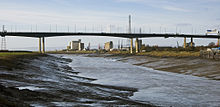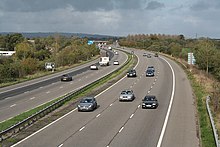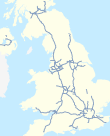M5 motorway: Difference between revisions
No edit summary |
No edit summary |
||
| Line 39: | Line 39: | ||
==Junction 12== |
==Junction 12== |
||
Junction 12 was originally a northbound exit only junction. In 2002 a southbound exit was added. The [[Highways Agency]] did not anticipate the traffic flows through the junction and the resultant queues can now extend back onto the motorway.<ref name="bbc20051118">{{cite news |url=http://news.bbc.co.uk/1/hi/england/gloucestershire/4448870.stm |title=Agency admits error over junction |work=BBC News |publisher=British Broadcasting Corporation |date=2005-11-18 |accessdate=2008-01-01}}</ref> This is because of an increase in traffic from Stroud intending to use the M5 northbound. The distance from junctions 12 and 13 is similar and traffic congestion is heavy on the A419 towards junction 13 whereas it is usually lighter on the B4008 towards junction 12. As traffic leaving the M5 northbound towards Gloucester needs to give way to this traffic coming from the B4008 |
Junction 12 was originally a northbound exit only junction. In 2002 a southbound exit was added. The [[Highways Agency]] did not anticipate the traffic flows through the junction and the resultant queues can now extend back onto the motorway.<ref name="bbc20051118">{{cite news |url=http://news.bbc.co.uk/1/hi/england/gloucestershire/4448870.stm |title=Agency admits error over junction |work=BBC News |publisher=British Broadcasting Corporation |date=2005-11-18 |accessdate=2008-01-01}}</ref> This is because of an increase in traffic from Stroud intending to use the M5 northbound. The distance from junctions 12 and 13 is similar and traffic congestion is heavy on the A419 towards junction 13 whereas it is usually lighter on the B4008 towards junction 12. As traffic leaving the M5 northbound towards Gloucester needs to give way to this traffic coming from the B4008, the queue on the motorway can extend beyond the first sign for the junction. |
||
==Features== |
==Features== |
||
Revision as of 01:28, 28 November 2008
- This article is about the M5 motorway in England. See M5 for other roads numbered "M5".
The M5 is a motorway in England. It runs from the M6 at Great Barr to Exeter in Devon. Heading south from the M6, the M5 runs east of West Bromwich and west of Birmingham through Sandwell Valley. The road continues past Bromsgrove, Droitwich Spa, Worcester, Tewkesbury, Cheltenham, Gloucester, Bristol, Weston-super-Mare, Bridgwater and Taunton on its way to Exeter, ending at Junction 31. It is the primary gateway to south-west England and can get very busy in summer months, especially after 3pm on a Friday afternoon until 8pm between Junctions 15 and 24.
Construction phases
Initial construction
The first 26 miles (42 km) of the M5 motorway to be built was constructed as a four-lane motorway (two lanes in each direction). This section, from Junction 4 (Lydiate Ash) in the north to a trumpet junction with the M50 in the south, opened in 1963.[1] The southern end was called a trumpet junction because of its shape: a 270 degree curved bend. There were no other exits from this trumpet junction though room was left for an extension to the south.
Another section, the Filton bypass, was built near Bristol around the same time. This is now the section between junctions 16 and 17.[2]
The motorway was extended in sections, from 1967 to 1970, northwards from Junction 4; and Frankley services was built. Much of the northern section beyond Junction 3, from about Quinton to its junction with the M6 motorway, was elevated motorway built on concrete pillars. The northern extension was a six-lane motorway (three lanes in each direction).[1]
It was also extended southwards, in sections, from 1967 to 1977, through Somerset, to Exeter, as a six-lane motorway (three lanes in each direction).[1]. A new services area was also built nearby, Strensham services. It appears that the short section between junctions 27 and 29 was opened a few years earlier than its adjoining section, as the A38 Cullompton Bypass. The termini for this section have since been removed, although part of the southern terminal roundabout is now used as an emergency access.[3]
M42 link
In the late 1980s a new junction 4a was built as part of the M42 motorway construction project. The route of the M42 was decided as early as 1972 but, due to planning delays, approval at the Bromsgrove end was not obtained until 1986.[4]
Widening the four-lane section
The first-built section of M5, from junctions 3 to 8, was widened to provide six lanes (three lanes in each direction) in the early 1990s. During this work the Northbound Strensham Services was completely rebuilt further away from the new junction. Junctions 7 and 8 were also remodelled into a roundabout junction.[5]
Addition of crawler lanes

The Avonmouth Bridge was converted to eight lanes (four lanes in each direction) in the early 2000s. Later, in 2005–2006, parts of the M5 between Junctions 17 and 20 were widened to 7 lanes (four lanes climbing the hills and three lanes descending the hills); information boards were added and parts of the central reservation was converted to a concrete crash barrier. During this stage of construction the M5 became Britain's longest contraflow system,[6][7] spanning 9 miles (14 km) between junctions 19 and 20. The M5 contraflow was said to be the most complicated ever built in the UK as the motorway is on a split level going around the steep hills of Gordano Valley; meaning four lanes plus an additional emergency vehicle lane were squeezed into that section.[8] Most of the contraflow had speed limits of 40 mph (64 km/h) and required six speed cameras to enforce the speed limit through the narrow lanes.[9]
Junction 12
Junction 12 was originally a northbound exit only junction. In 2002 a southbound exit was added. The Highways Agency did not anticipate the traffic flows through the junction and the resultant queues can now extend back onto the motorway.[10] This is because of an increase in traffic from Stroud intending to use the M5 northbound. The distance from junctions 12 and 13 is similar and traffic congestion is heavy on the A419 towards junction 13 whereas it is usually lighter on the B4008 towards junction 12. As traffic leaving the M5 northbound towards Gloucester needs to give way to this traffic coming from the B4008, the queue on the motorway can extend beyond the first sign for the junction.
Features

Notable features of the M5 include the four level Almondsbury Interchange, between the M5 and the M4 near Bristol. Another is the Avonmouth Bridge that is often a bottleneck in heavy traffic. Beyond that are the split-level carriageways, as the motorway climbs the sides of the hills above the Gordano valley, between Portishead and Clevedon. Junction 1 surrounds a surviving gatehouse from the former Sandwell Hall.
The M5 follows the route of the A38 road quite closely. The two deviate slightly around Bristol and the area south of Bristol (junctions 16 to 22). The A38 goes straight through the centre of Bristol and passes by Bristol International Airport; whereas the M5 skirts around both of them, with access to the airport from junctions 18, 19 or 22. The A38 continues south from where the M5 finishes in Devon.
Between Junction 21, Weston-super-Mare and Junction 22, Burnham-on-Sea, the M5 passes by Brent Knoll and has a long gradual curve that deviates from the straight line of the motorway. It is commonly believed that this is because it is to bypass the hill and village, but it is in fact down to an error in the compulsory land purchases made at the time which left the route of the motorway having to arch around this area.[citation needed]
Junctions
| M5 Motorway | ||
| Northbound exits | Junction | Southbound exits |
| The NORTH WEST, Wolverhampton, Birmingham (North & East), Walsall M6 | M6, J8 (52°32′53″N 1°57′54″W / 52.548°N 1.965°W) |
Start of motorway |
| West Bromwich, Birmingham (North West) A41 | J1 | West Bromwich, Birmingham (North West) A41 |
| Dudley, Wolverhampton, Birmingham (West) A4123 | J2 | Dudley, Wolverhampton, Birmingham (West) A4123 |
| Halesowen, Birmingham (South West & Central) A456 | J3 | Halesowen, Birmingham (South West & Central) A456 |
| Frankley Services (52°25′44″N 2°01′05″W / 52.429°N 2.018°W) | ||
| Bromsgrove A38 | J4 | Bromsgrove A38 |
| NEC, Birmingham Airport, Redditch M42 London (M40, M1) | J4a (52°21′15″N 2°04′11″W / 52.3542°N 2.0698°W) |
Birmingham (South & East), Redditch M42 London (M40) |
| Droitwich Spa A38 | J5 | Droitwich Spa A38 |
| Worcester (North) A449 | J6 | Worcester (North) A449 |
| Worcester (South) A44 | J7 | Worcester (South) A44 |
| Strensham services | ||
| SOUTH WALES, Ross M50 | J8 | SOUTH WALES, Ross M50 |
| Tewkesbury A438 Evesham A46 | J9 | Tewkesbury A438 Evesham A46 |
| No access | J10 | Cheltenham A4019 |
| Cheltenham, Gloucester (North), Gloucestershire Airport A40 | J11 | Cheltenham, Gloucester (North), Gloucestershire Airport A40 |
| Gloucester (East) A417 | J11a | Gloucester (East) A417 |
| Gloucester (South) A38 | J12 | Gloucester (South) A38 |
| Stroud A419 | J13 | Stroud A419 |
| Michaelwood services | ||
| Dursley, Charfield, Falfield, Wotton-under-Edge B4509 | J14 | Thornbury, Charfield, Falfield, Wotton-under-Edge B4509 |
| London, Bristol (M32), South Wales, Chepstow (M48) M4 | J15 Almondsbury Interchange |
London, Bristol (M32), South Wales, Chepstow (M48) M4 |
| Thornbury, Filton A38 | J16 | Thornbury, Filton A38 |
| Bristol (West) A4018 Severn Beach B4055 |
J17 | Bristol (West) A4018 Severn Beach B4055 |
| South Wales, Cardiff, Newport M49 | J18a | No access |
| Avonmouth, Avonmouth Docks A4 | J18 | Avonmouth, Avonmouth Docks A4 |
| Avonmouth Bridge | ||
| Portishead, Royal Portbury Dock , Easton in Gordano A369 | J19 Gordano Services |
Portishead, Royal Portbury Dock, Easton in Gordano A369 |
| Nailsea, Clevedon B3133 | J20 | Nailsea, Clevedon B3133 |
| Weston-super-Mare, Bristol (South) A370 | J21 | Weston-super-Mare A370 |
| Sedgemoor services | ||
| Burnham on Sea, Weston-Super-Mare, Bristol (South), Airport A38 | J22 | Burnham on Sea, Highbridge A38 |
| Highbridge A38 Glastonbury, Wells A39 |
J23 | Bridgwater A38 Glastonbury, Wells A39 |
| Bridgwater, Minehead A38 | J24 Bridgwater services |
Minehead, (A39) A38 |
| Taunton, Yeovil A358 | J25 | Taunton, Honiton, Yeovil, Weymouth A358 |
| Taunton Deane services | ||
| Wellington, Taunton A38 | J26 | Wellington A38 |
| Barnstaple, Tiverton A361 Wellington A38 Tiverton Parkway railway station |
J27 | Barnstaple, Tiverton A361 Willand (B3181) Tiverton Parkway railway station |
| Cullompton B3181 | J28 Cullompton services |
Cullompton B3181 Honiton A373 |
| Honiton A30 Exeter International Airport A3015 |
J29 | Honiton A30 Exeter International Airport A3015 |
| Exeter A379 Sidmouth, Exmouth (A3052) A376 |
J30 Exeter services |
Exeter A379 Sidmouth, Exmouth A376 |
| Start of motorway | J31 | Bodmin, Okehampton A30 |
| Bodmin, Okehampton A30 Non-motorway traffic |
Road becomes A38 from/to Plymouth and Torquay | |
See also
References
- ^ a b c Charlesworth, George (1984). A History of British Motorways. London: Thomas Telford Ltd. ISBN 0-7277-0159-2.
- ^ Ordnance Survey One Inch Map of Great Britain, Series 7 Sheet 156, major roads revised 1963.
- ^ SABRE Photo Gallery: Click image to close this window
- ^ The Motorway Archive - M42
- ^ The Motorway Archive - M5 Widening, junctions 3 to 8
- ^ Sky News - UK's Longest Contraflow
- ^ BBC News - 'Most complex' contraflow
- ^ Western Daily Press - West beware! It's Britain's biggest road contraflow
- ^ Road Traffic Technology - RedSpeed International Take On Europe's Largest Contraflow
- ^ "Agency admits error over junction". BBC News. British Broadcasting Corporation. 2005-11-18. Retrieved 2008-01-01.

